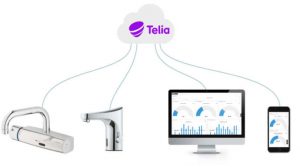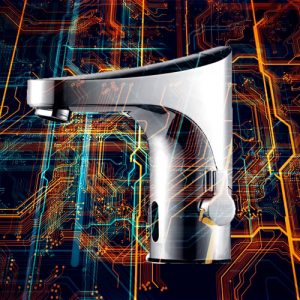Regular flushing of water outlets in healthcare facilities is an important step in preventing the growth and spread of harmful bacteria such as Pseudomonas and Legionella in the water system. These bacteria can cause serious infections in patients, especially those who are immunocompromised or have underlying health conditions.
Pseudomonas is a type of gram-negative bacteria that can survive in a wide range of environments, including water. It can cause infections in the lungs, urinary tract, and skin, and has been known to cause outbreaks in healthcare facilities. Legionella, on the other hand, is a type of gram-negative bacteria that thrives in warm water and can cause severe lung infections such as Legionnaires’ disease.
One of the main ways to prevent the growth and spread of these bacteria in healthcare water systems is through regular flushing of outlets. This process involves running water through the outlets for a minimum of 5 minutes to ensure that any bacteria present in the system are flushed out Click Here to Find out how. This is particularly important for outlets that are not used frequently, as these are more likely to harbor bacteria.
Flushing can be done manually or automatically. Manual flushing involves physically turning on  each outlet and letting the water run for 5 minutes. This process can be time-consuming and may not be practical in large facilities. Automatic flushing systems like our WMS System, on the other hand, can be programmed to flush the outlets at regular intervals, making the process more efficient.Click Here to Find out more.
each outlet and letting the water run for 5 minutes. This process can be time-consuming and may not be practical in large facilities. Automatic flushing systems like our WMS System, on the other hand, can be programmed to flush the outlets at regular intervals, making the process more efficient.Click Here to Find out more.
When flushing the outlets, it is important to use the highest possible flow rate to ensure that the bacteria are thoroughly flushed out. The water should be run for a minimum of 5 minutes and ideally at least 15 minutes, and the outlets should be flushed at least once a week. This frequency may need to be increased in areas where there is a higher risk of bacterial growth, such as in patient rooms or areas with a high water temperature.
 It’s also important to pay special attention to “dead legs” or outlets that are not used frequently. These outlets can harbor bacteria and may require more frequent flushing. A “dead leg” is a section of the water supply system that is isolated and not in use, which can provide an environment that is conducive to the growth of bacteria. These areas are often overlooked during regular maintenance and cleaning, making them more susceptible to bacterial growth. Therefore, it’s essential to flush these outlets more frequently, at least once a week. This will help to ensure that any bacteria present in the system are flushed out and prevent the growth and spread of harmful bacteria such as Pseudomonas and Legionella in the water system.
It’s also important to pay special attention to “dead legs” or outlets that are not used frequently. These outlets can harbor bacteria and may require more frequent flushing. A “dead leg” is a section of the water supply system that is isolated and not in use, which can provide an environment that is conducive to the growth of bacteria. These areas are often overlooked during regular maintenance and cleaning, making them more susceptible to bacterial growth. Therefore, it’s essential to flush these outlets more frequently, at least once a week. This will help to ensure that any bacteria present in the system are flushed out and prevent the growth and spread of harmful bacteria such as Pseudomonas and Legionella in the water system.
Another important aspect of flushing the water outlets in a healthcare facility is to use draw dosed and treated water through the system. This method ensures that the treated water reaches all parts of the system, including the dead legs and seldom used outlets. Draw dosing involves adding a small amount of chemical disinfectant to the water supply, which is then flushed through the system. This helps to kill any bacteria present in the system and prevent the growth and spread of harmful microorganisms. The treated water should be flushed through the system at a high flow rate, to ensure that it reaches all parts of the system. This method is particularly effective in preventing the growth of bacteria in areas where regular flushing may not be possible or practical.
In addition to flushing the outlets, other measures can be taken to prevent the growth and spread of bacteria in healthcare water systems. These include regular cleaning and disinfection of the water system, monitoring the water temperature and pH levels, and conducting regular testing for bacteria.
It’s also important to keep in mind that the water supply system should be regularly maintained. This includes regular cleaning and disinfection of the system, monitoring the water temperature and pH levels, and conducting regular testing for bacteria.
There are several recent UK-published scientific papers that support the effectiveness of regular flushing in preventing the growth and spread of harmful bacteria in healthcare water systems.
One such study, “Prevention of waterborne infections associated with healthcare facilities: the role of flushing and thermal disinfection” published in the Journal of Hospital Infection (2018) by D. W. M. Harnisch, J. A. J. W. Kluytmans, and M. J. A. J. Verhoef, found that regular flushing of water outlets in healthcare facilities is an important measure in preventing the growth of Legionella and other waterborne pathogens. The study also found that thermal disinfection, which involves heating the water to a high temperature, can be an effective method for controlling bacterial growth in the water system.
Another study, “Prevention of Pseudomonas aeruginosa colonization in hospital water systems: comparison of different strategies” published in the Journal of Hospital Infection (2019) by L. A. P. Hoekstra and colleagues found that regular flushing of water outlets in combination with other measures such as chlorine dosing and routine monitoring was effective in preventing the colonization of Pseudomonas aeruginosa in hospital water systems.
A study by “Water hygiene in hospitals: Legionella and Pseudomonas” published in the Journal of Hospital Infection (2020) by J. A. J. W. Kluytmans and colleagues, found that regular flushing of outlets in combination with other measures such as chlorine dosing and routine monitoring was effective in preventing the growth and spread of Legionella and Pseudomonas in hospital water systems.
These studies support the effectiveness of regular flushing of water outlets in preventing the growth and spread of harmful bacteria in healthcare water systems. It is important to note that regular flushing should be combined with other measures such as chlorine dosing, thermal disinfection and routine monitoring to ensure the safety and cleanliness of the water supply.
In conclusion, regular flushing of water outlets in healthcare facilities is an important step in preventing the growth and spread of harmful bacteria such as Pseudomonas and Legionella in the water system. This process involves running water through the outlets for a certain period of time to ensure that any bacteria present in the system are flushed out. When flushing the outlets, it is important to use the highest possible flow rate and flush at least once a week. Along with this, other measures such as regular cleaning, disinfection, monitoring, and testing should be taken to ensure the safety and cleanliness of the water supply.
To Watch or New Video Click Here to Find out more detail on how you can effectively and efficiently flush your complete water system

